How to build an email database in 6 steps and collect email contacts
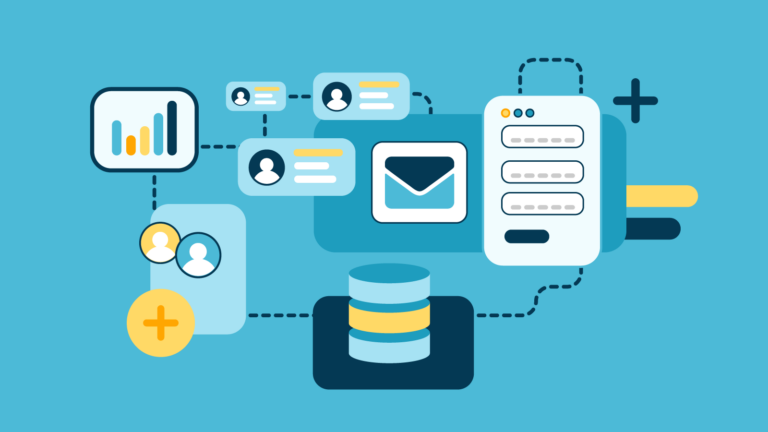
Before you start:
- make sure you have a secure and reliable email mailing tool that protects you from dangerous and invalid email addresses
- use a platform that allows you to easily and automatically import the contacts you collect
- if you don’t want to have limits on the number of contacts you collect, you may prefer a solution like MailUp, which doesn’t increase the price if you add new contacts
Infinite databases and unlimited mailing: activate a free trial of MailUp today, it’s free!
The key to building a high return on investment Email Marketing strategy is having a quality database and lists of valid email addresses.
There are several things that can threaten the quality of your contact lists and worsen the open and click rates of your emails.
How do I build a quality database? What are the rules to follow to have valid email lists? And how can you ensure the effectiveness of your mailings?
Find out in this easy Database Building guide for emails!

From developing integrations to strategic support, from creating creative concepts to optimizing results.
What is a database?
A database is a database of a company’s customers and prospects. This data includes name and surname, email address and other contact details (gender, age, city, profession and company, telephone number, etc.).
In Email Marketing, the database plays a central role because it collects valuable data on contacts who have shown interest in your company. This is data that you can use to tap into their interests and needs with targeted emails.
How do I build an email address database?
There are two ways to build a database:
- use your online channels (website, blogs, social media) and offline channels (industry events and fairs) to collect customer and prospect email addresses from scratch
- buy email address packages from specialized companies for quick, immediate data collection
Is it better to buy email lists or gain them over time?
In your opinion, is it better to have a database of contacts who have expressed interest in receiving messages from your company or a database of purchased addresses, ones which perhaps match recipients far outside your business’ target audience, who aren’t very interested in your brand or responsive to it?
Focusing on the quality of the database, while recognizing the time and consistency that this strategy requires, is the only way to guarantee results for your email campaigns and have a return on investment.
There are many risks in buying email databases:
- they can contain incorrect or invalid addresses
- legal repercussions and non-compliance with GDPR (due to purchasing addresses that haven’t given consent)
- increase in bounce rate, i.e. emails that go back to the sender and can’t be delivered (an even more serious consequence if you don’t have an automatic bounce management system like the one provided by MailUp)
- spam notifications and damage to your reputation as a sender
- poor engagement with recipients
- very low conversion rates and return on investment of your email activities
What are mailing lists?
Another key concept for Email Marketing is mailing list (or email lists). If the database is a company’s database, the mailing list is the collection of all email addresses of people who express an interest in receiving messages from your company and express consent to sharing their data with you.
Today this expression of interest and sharing of data have become two fundamental aspects of Email Marketing. If the email list was once considered a list of addresses to send messages to en masse, without paying much attention to the data, today the concepts of segmenting email lists and data curation that complete the profile of a contact are the basis of any Email Marketing activity.
This is why mailing lists must evolve and be conceived as a starting point that must be expanded, managed, monitored and, above all, clustered to create more specific and detailed target audiences:
- expanded, continuing to consistently collect potential new contacts from your online and offline activities (we’ll see how to do this effectively in the following sections)
- managed and monitored, cleaning the list of addressees who receive your emails of all those incorrect, invalid or disinterested contacts (always inserting an unsubscribe link in the message footer and relying on a secure mailing infrastructure such as MailUp)
- clustered, upgrading from a mailing list to the segment list concept.
This last point is perhaps the most important to follow if you want to get results from your Email Marketing activities. MailUp offers mailing list management that facilitates this step because it provides a platform with a multi-list environment. What does that mean? Simply put, that those who choose MailUp can create a list for each type of contact in the database: a list for subscribers to the newsletter, one for those who have given consent to receive promotions and commercial emails, one for all customers, one for high-spending customers and so on.
Try MailUp for free, no strings attached: experience the multi-list environment and discover its many benefits.

An example of a multi-list environment, directly from our MailUp platform
Profiled email addresses: why profiling is important
Developing a mailing list into a segment list by dividing your database into different targets is only possible if you use profiled email lists, i.e. lists of contacts that, in addition to the email address, have a set of detailed contact information associated with them (e.g. personal, geographical and behavioral data).
Profiling is a marketing technique that involves collecting and analyzing user data to create a well-defined digital identity, which establishes who they are, what their online behavior is, and what their interests and their habits are.
But why is profiling important in Email Marketing? Simple: The more information you know about your recipients, the more you will be able to tap into their interests and needs with customized campaigns, increasing the chances of clicks, conversions and purchases.
Profiled mailing lists vs. unprofiled mailing lists
Thanks to a collection of profiled email contacts, you’ll have a set of additional information about the recipient, requests during subscription, and the granting of the email address by the contact.
Now, what can you do with this information? How can you use it and for what purpose?
You can use these profiled addresses to create target groups (also called segments) within your database, categorized by:
- personal data (gender, age, place of residence)
- behavioral data (the actions they take following specific stimuli)
- purchase data (purchased products, preferences, frequency)
For example, a restaurant chain may only need to notify its contacts (customers and potential customers) who reside in Milan of a new restaurant opening in the province.
Why is it useful to have profiled email lists in this case? To find out which contacts to send the notification of the new restaurant opening and any offers.
If you have a platform with a multi-list environment like MailUp, you can track these same activities to create different lists within a single mailing platform instead of creating targets within a single list. The difference? The difference lies in the degree of segmentation. By creating different lists in a multi-list environment, you can then do an even finer and detailed segmentation. You can create different lists based on a common denominator that shares a macro-group of database users (segmentation step 1). Subsequently, you can create more specific targets within each list, as well as the groups you can decide to include or exclude in your mailings (segmentation step 2).
Let’s take an example:
Let’s say that a restaurant chain has a single large database, divided into three different lists: a list to send promotions to customers, a list to send the newsletter (to customers and prospects), and a list to manage communications with suppliers.
From a single profiled database, an initial segmentation was then made by creating 3 email lists (each with a different common denominator).
In each of these 3 lists, the company created different groups, grouping contacts according to other personal or behavioral information. For example, in the list for sending promotions to customers, these groups were created:
- high-spending customers
- inactive customers (to send re-engagement campaigns to try to encourage them)
- newly acquired customers (to send welcome campaigns and onboarding with dedicated discounts)
What happens to unprofiled email lists? In this case you couldn’t create specific lists by type of mailing or recipient, but you could send the same email to all email addresses in the database en masse.
Taking the above example, without profiled lists, an email about a discount reserved for MailUp premium customers would go out to all recipients, even those who aren’t premium customers and have no interest in receiving the message.
Many users may consider the email received irrelevant, perhaps even annoying, leading to consequences such as:
- an increase in spam notifications
- unsubscribing recipients and the loss of valid contacts
- damage to the sender’s reputation
- very low conversion rates
- wasted budget and time
Profiling forms
Using a profiling form, like those provided by MailUp, is just what you need to group your recipients according to their preferences.
An example can be to create two groups of recipients, “Sea” and “Mountain”, and then create a self-profiling form to understand which type of holiday destination your audience prefers. By replying, the recipients will be subscribed to the corresponding group and will be able to receive emails with targeted content about their interest.
In addition to organizing recipients into groups, MailUp profiling forms can be used for other purposes:
- adding details to a recipient’s profile to take advantage of a discount (“Enter your date of birth to receive a gift on your birthday”)
- verifying the validity of the data entered during the subscription phase, if a long time has passed
- specifying interests (offering a choice of options in the form, where each option corresponds to a group in the email list).
The data collected through these forms then ends up in the contact’s personal fields, which are the MailUp tool that allows you to create groups or filter the database by segments.
Collecting complete, profiled email addresses is therefore essential so you can send effective email campaigns and maximize investment. However, it’s also crucial to understand how this collection should take place, what the channels and best practices to follow are.
Let’s take a look at it together in 6 easy steps.
To summarize:
- avoid buying pre-packaged address lists
- build your database by collecting contacts from online and offline channels
- collect profiled email addresses, or collect personal and behavioral data in addition to emails to create complete user profiles
- enter your contacts in different lists for an initial segmentation of the database. For each list, segment further by creating user groups based on their data
- use professional tools to collect contacts, such as profiling forms
The 6 steps to build a quality database
1. Collect your contacts online
- on your company’s website or blog. A subscription form can be useful to convince visitors who come to your site through search engines to subscribe to your newsletters. You can insert a form on all pages of the website or only on the homepage or you can create a pop-up form.

Example of a pop-up form
- on social media. You can place a subscription form directly on your Facebook business page or use Google Ads (a form will appear when you click on the ad).
If your Email Marketing platform, like MailUp, makes integration available, all contacts who subscribe and fill out the form will automatically end up in the chosen email list, without any manual intervention.
- on WordPress. WordPress is among the most used CMS and there are many plugins available. So, if, like many, you use WordPress for your company website or blog, you can use a plugin like MailUp for WordPress to insert a contact collection form on your website pages and find the email addresses of new subscribers directly on your mailing platform.
MailUp for WordPress is a plugin that you can also use in the free trial version of MailUp! Activate your no-obligation trial now and find out how to collect contacts with this plugin.
- through links to your company signature. While it’s often underestimated, the signature you set for your personal address can be a great strategy for inserting an invitation to subscribe to the newsletter via a link to the subscription form. In fact, your company email reaches many people: prospects, customers, suppliers. So why not take advantage of this showcase too?
- by downloading relevant content. Guides, e-books, webinars, white papers: all the resources you create can represent opportunities to obtain important data and collect new addresses, simply by inserting a download form to download the resource with an email field and other relevant information inside.
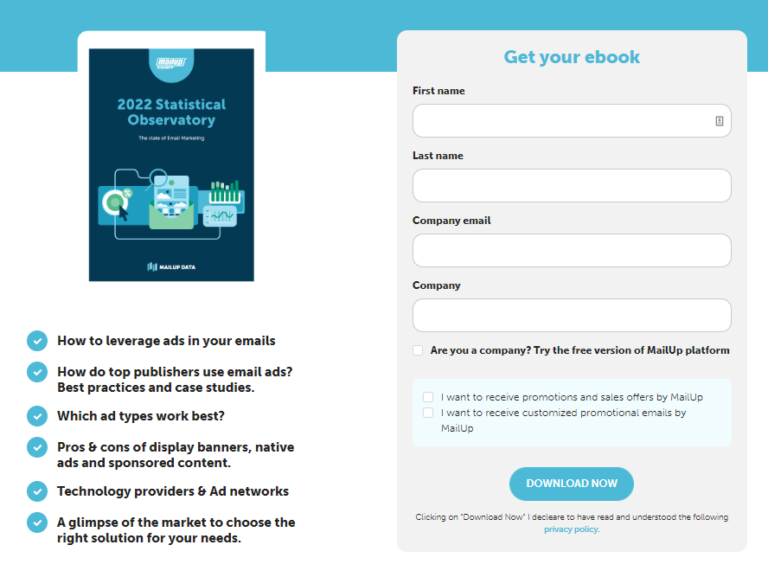
Create and customize your subscription forms
Once you consider all these channels, what you need is a real means where you can collect contacts and their accompanying data: a subscription form.
There are many ways to create subscription forms. MailUp offers several ways to collect contacts online:
- a subscription form with the Drag & Drop Editor
- an HTML builder
- a pop-up subscription form.
- a profiling form
Each MailUp subscription form is highly customizable. Here is an example of the drag & drop editor interface that allows you to enter any content:
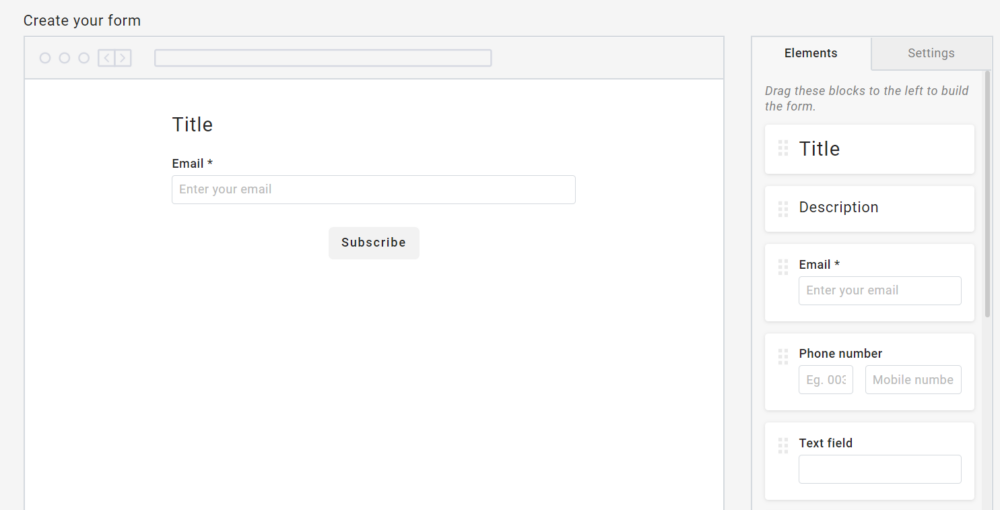
With MailUp you also have the possibility of inserting an invisible captcha, useful for protecting the form from abuse, spamming, and bots auto-filling the form.
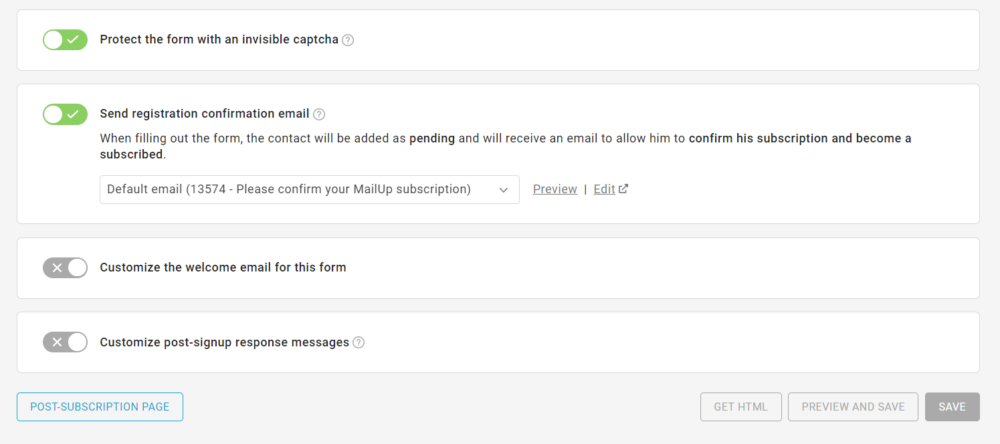
Note! The MailUp captcha protects your forms without being visible to the user. This means subscription is faster, but still secure.
Create post-subscription flow
The subscription form is just the first step in collecting subscribers online through your website.
There are in fact other steps that are needed to build a full customized subscription flow for all the steps:
- creating the subscription confirmation email (if you have chosen the double opt-in subscription method)
- creating the post-subscription message, displayed on a page that is used to show the result of the subscription (it can be a “Thank you for subscribing! Soon you will receive our newsletters” or a “Your email address is already subscribed to our newsletter”)
- creating the welcome email, sent automatically after the contact subscribes
Did you know that welcome emails are 86% more effective than any other newsletter? And that 76% of new subscribers expect to receive one? Post-subscription is the most responsive moment of co
Customize post-subscription flow
In such a crucial phase as post-subscription, it becomes essential to customize the very first user experience with your brand. How? By associating different post-subscription messages, confirmation emails, and welcome emails, depending on the subscription form created for the activated subscription funnel and that relate to that form.
Example: for the blog section on your website you’ll need a different form than the one on the home page and, consequently, you will want to build an ad hoc post-subscription flow for the blog subscription funnel.
One of the latest features of MailUp, available in the Plus, Premium and Enterprise editions, allows you to do all this. For all the subscription forms created with the drag & drop editor you can nowassociate a subscription confirmation email sent automatically and customized based on the form created and the type of subscription flow created. It’s the same for welcome emails and post-subscription messages:

You can then build a specific post-subscription flow for each subscription collection funnel, depending on the purpose of each form and the context in which you place it.
2. Collect new offline addresses
Potential contacts aren’t only collected online. If your company often participates in fairs and events, if you hold training workshops, or if you have a physical store as well as an e-commerce store, you can also take advantage of these touchpoints with the public to collect email addresses.
There are many ways to do this: you can insert a QR code on the stand of an event that leads to a landing page with a subscription form or you can take advantage of your physical store to ask the customer to leave an email address and access a discount.
3. Create a legally compliant mailing list
This step doesn’t take place afterwards but at the same time as the two previous phases of contact collection. Indeed, during the latter, all your collection methods (whether by form or by paper format in the store) must include an explicit request for consent to contact.
The GDPR imposes limitations on companies on the collection and use of personal data. This doesn’t mean that you can’t collect email addresses, but that your data collection activities must always take place in compliance with the regulations. In practical terms, this means that before sending email campaigns to an address, you must make sure that it has given you specific consent to receive marketing communications from your company. In order to be considered valid, consent must be specific to each purpose to be pursued, informed, free, unequivocal, demonstrable, and revocable.
Therefore, when creating a subscription form, make sure to always insert a field dedicated to the collection of privacy consents (the consent must be collected for each purpose that you intend to pursue and a form can then collect multiple consents) and a link that refers to the information on data processing. In other words, one or more boxes must be included that the user can freely tick to give their consent for your company’s specific activities.
To help you remember this fundamental step, the MailUp platform already includes an editable field in the contents to be dragged in the drag & drop subscription form that can be used to collect all privacy consents, along with a reminder to insert the link to the privacy policy.
However, we recommend that you consult with expert consultants to ensure that your contacts are collected correctly and in a compliant manner, avoiding the risk of incurring penalties.
4. Adopt the double opt-in method
Concurrently with the subscription collection phase is when you choose which subscription method to adopt: single opt-in or double opt-in?
If these two terms don’t tell you anything, let’s go over them briefly:
- the single opt-in is a subscription method where the contact, once they have filled out the subscription form and clicked on the form’s confirmation button, is fully subscribed to your email list, without any intermediate step.
- the double opt-in (also called confirmed opt-in) requires that the contact automatically receive a subscription confirmation email after filling out the form with a link or a CTA button to be clicked to definitively complete subscription. Thus, it is a further step that serves to ensure that the email address entered is valid and owned by the contact.
Which of the two to choose? Here is an article that compares the two strategies.
MailUp expert advice: after weighing up the pros and cons, we recommend the double opt-in as the best practice for collecting verified email addresses, with the recipient’s full consent and interest, and for better database quality assurance.
5. Import your contacts
If you have already completed all the contact collection activities that we have explained to you so far and you already have a list of email addresses, then to start sending newsletters to all your contacts you just have to import them into a professional email mailing platform like MailUp.
If you don’t want to have to pay close attention to the number of contacts to import every time, our advice is to choose an Email Marketing platform that doesn’t impose limits on the number of contacts in your database. Many solutions, even the most famous ones on the market, offer subscriptions whose cost increases if you have a certain number of contacts. If your goal is to gain more and more subscribers and grow, choosing such solutions can be very expensive.
The MailUp platform is one of the few that allows you to send emails you want to all contacts in an unlimited way. You can then import your new contacts each time without worrying about additional costs. The price varies according to the speed with which your emails are sent, without affecting the size of your database.
How to import your email addresses
Importing a list of email contacts or a single address is easy. With MailUp you just have to go to Recipients > Import and select the method that’s right for you from the many ones available
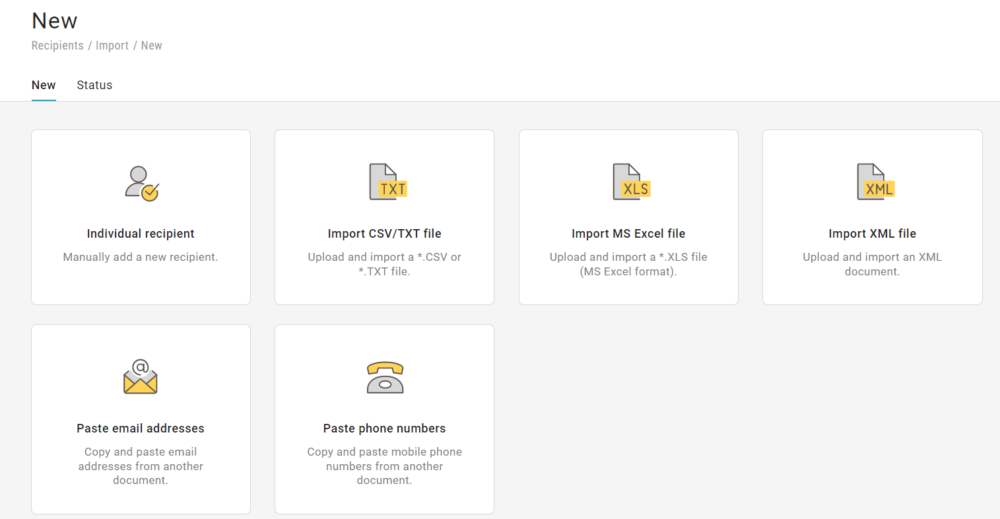
For bulk import contacts we recommend that you select Import CSV file or Import MS Excel file.
Here are the steps you’ll need to take to import all your contacts in just a few minutes:
- Choose the file where you keep all your addresses from your PC and upload it to the platform by clicking on Upload;
- Then select the group in your list where you want to import contacts or click Create New Group
- Now link the columns of your file with the MailUp personal fields. What does that mean? Simply put: if column A of your file contains the email address and columns B and C contain the name and surname of your contacts, you’ll have to associate each of these three columns with MailUp’s respective personal fields: Email Address, Name, and Surname. If the first line of your file contains the field names, you just need to tick the “skip first row” box.
All you have to do is click Import and you will find the imported contacts in your list or, if you have selected a target group, you will find them by following the Recipients > Groups path
6. Cleaning up the database
Now you can start sending emails to your audience.
However, the database building steps aren’t over. One is missing, and it’s perhaps the most important: cleaning the database.
Monitoring the status of your database is a key activity to preserve its quality and to ensure the efforts you made in the first steps weren’t for nothing.
How do you clean a database? There are several best practices you can adopt:
Make unsubscribing easier
If a contact is no longer interested in receiving messages from your company and doesn’t know how to unsubscribe, they’ll stop opening your emails and will flag the message as spam or junk mail, with unpleasant repercussions on your deliverability and sender reputation.
Clearly inserting a link to unsubscribe in the footer of your emails (i.e. at the bottom) is not only a question of transparency, but most importantly, of cleaning the database of contacts who are no longer interested in you.
Remember that quality beats quantity when it comes to database building.
Preference Center
In many other cases the user doesn’t want to unsubscribe but wants to be able to choose what type of emails they receive from your company. Alongside the possibility of unsubscribing, a link to the Preference Center allows you to give your recipients a valid alternative to those users who still want to maintain a relationship with your company while allowing them to manage the type and frequency of the communications they receive.
The same page can also be reached in the unsubscribe confirmation step if you decide to set a double opt-out (i.e. a double unsubscribe step).
Insert a permission reminder
In addition to unsubscribe links and the preference center, it’s always useful to also include a Permission Reminder in the footer. This is a sentence that reminds the user how and why they are receiving that type of communication.
A permission reminder reminds them that a consent has been given to receive the communication and so prevents any spam notifications. It can also be useful for the system administrator, postmaster, or abuse desk manager to determine whether a spam notification is legitimate or not.
Managing inactive contacts
Internet Service Providers (ISPs) evaluate the quality of your database to see if you are a trustworthy sender. If the ratio between active and inactive users tends in favor of the latter, the ISP begins to consider you untrustworthy, thus automatically relegating your emails to the spam folder, until, in some cases, access to the mailbox is entirely blocked.
Identifying which contacts are inactive in your database is very important. In this case you can act on two fronts:
- try to reactivate them and grab their attention with targeted re-engagement campaigns (from abandoned cart to discounts on products they’re interested in). You can set up these campaigns automatically and establish a reactivation email flow to be sent at a time lapse of your choice as a reminder before you consider a contact permanently abandoned. With MailUp automation, you can set the mailing frequency, trigger conditions, and decide to remove contacts from the inactive group that respond positively to your campaign.
- for all contacts who do not respond positively, what you can do is make it easier for them to unsubscribe (how many times have you received an email like “Are you no longer interested in our products?”)
The goal here is to also understand which engagement gaps are hidden in your database, identify the inactive ones, and clean up your contact lists that don’t interact with your company and that don’t give any added value, but hinder your performance).
To summarize:
- collect contacts by adding subscription forms to your online channels
- take advantage of offline channels (events, conferences…) to collect email addresses
- remember to always ask your contacts for their consent to receive communications and to use personal data
- favor the double opt-in method to collect email addresses. Then send a confirmation email to make sure the addresses are valid.
- set the post-subscription flow to confirm subscription and welcome new members
- always keep the database clean. Add the unsubscribe link and the ability to change preferences in your emails
How much does it cost to build a quality database?
As you have seen from the advice we’ve given you, building a quality database is much easier if you rely on the tools of a professional Email Marketing platform. This can give you all the tools to build and maintain a database according to the best practices that we have explained to you:
- subscription form editor
- plugins to link your websites, blogs, or e-commerce store to mailing lists
- buttons set up to obtain privacy consents
- plugins to link your sites, blogs, or e-commerce store to mailing lists
- bulk import of contacts (unlimited with MailUp)
- automatic import of contacts from other applications
- automatic workflows to reactivate inactive contacts
All this at what cost? If you choose MailUp, you can start at no cost and put all these tools to the test by starting a free, no-obligation trial. If you decide to activate a full subscription with the platform, the cost for a standard subscription is only 39 euros per month (with the annual subscription) for an unlimited number of emails and recipients to reach.
Start creating your database with MailUp for free: try our platform now. Follow this link!